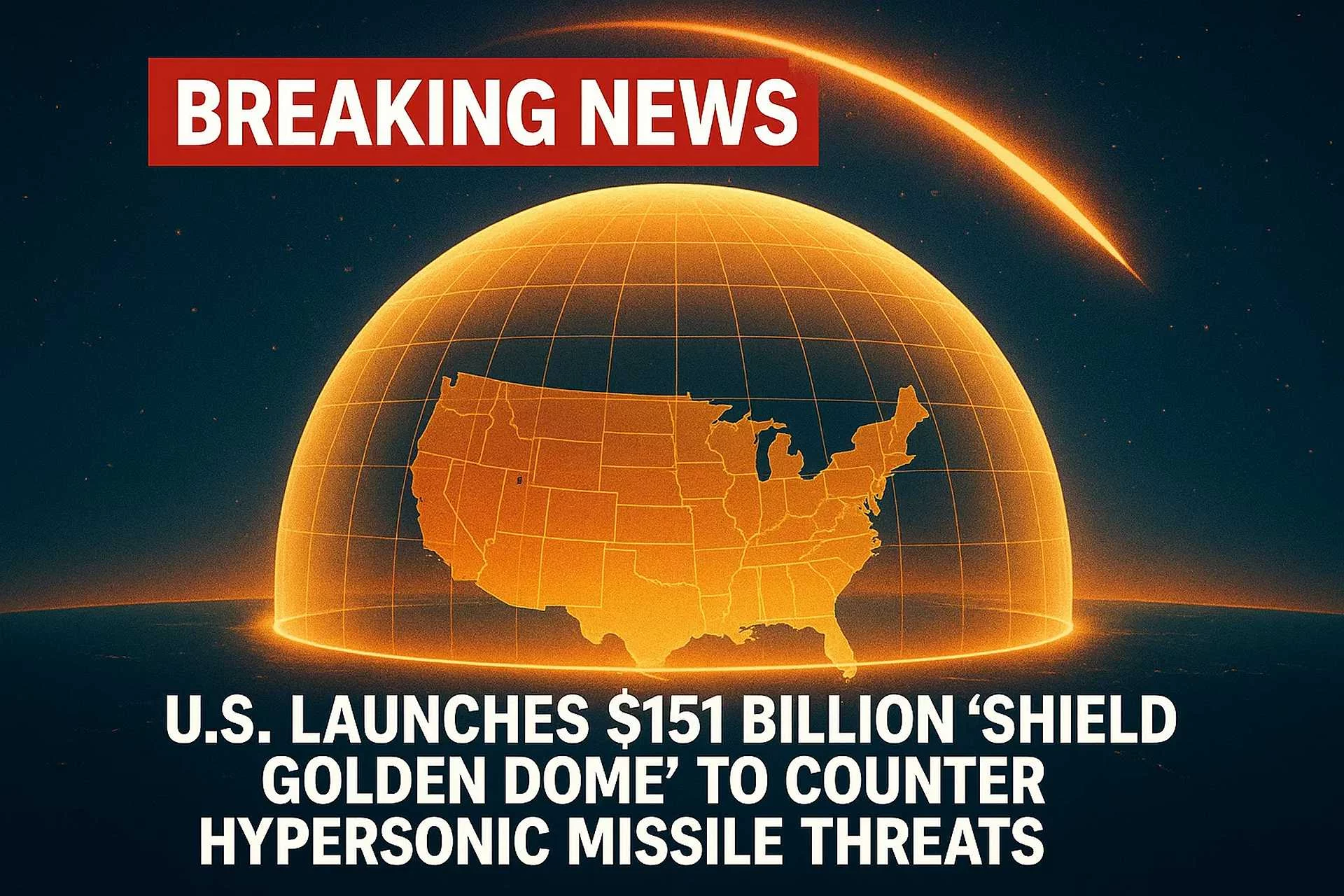Hold onto your seats, defense buffs! The United States has just dropped a bombshell with the launch of SHIELD (Scalable Homeland Innovative Enterprise Layered Defense)—a jaw-dropping $151 billion missile defense mega-program, affectionately dubbed the Golden Dome. Unveiled in a blockbuster Financial Times report on July 25, 2025, this historic initiative is set to weave an impenetrable, multi-layered shield over the continental U.S., ready to obliterate a terrifying array of missile threats—ballistic, cruise, and the lightning-fast hypersonic beasts. With an initial $13 billion already greenlit for kickstarting this colossal project, the race is on to safeguard America from an escalating global arms showdown!
The Golden Dome Rises: A Revolutionary Defense Fortress
Imagine a futuristic fortress in the sky! SHIELD, or Scalable Homeland Integrated Ecosystem for Layered Defense, is no ordinary defense system. This cutting-edge network fuses land-based interceptors, unblinking space-based sensors, next-gen radar arrays, and a brainy AI-powered command-and-control hub into a seamless defense tapestry. Tasked with overseeing this marvel is retired U.S. Space Force General Michael Guetlein, a defense titan now leading a freshly minted federal missile defense authority from Redstone Arsenal in Huntsville, Alabama. Already a nerve center for U.S. missile and aerospace innovation, Redstone will orchestrate this national defense symphony to tackle both today’s threats and tomorrow’s unknowns.
This isn’t just an upgrade—it’s a full-on revolution. SHIELD promises to outshine outdated systems like Ground-Based Midcourse Defense (GMD), Aegis BMD, and THAAD by detecting, tracking, and smashing threats across all flight phases: boost, midcourse, and terminal. Over the next decade, the U.S. will pump $151 billion into this beast, covering everything from interceptor development to cybersecurity fortresses and high-stakes weapons integration contracts. It’s a bold leap from reactive, fragmented defenses to a proactive, all-encompassing shield that could redefine global security!
Why SHIELD? The Missile Storm Brewing on the Horizon
The clock is ticking, and the U.S. isn’t taking chances. SHIELD is a direct counterpunch to the breakneck missile advancements by rival powers. China’s DF-17 hypersonic glide vehicle is already operational, Russia’s Avangard and Sarmat ICBMs (aka Satan II) loom large, North Korea’s Hwasong-17 nuclear-capable ICBMs keep testing boundaries, and Iran’s precision-guided missiles are raising red flags. These aren’t just threats—they’re a full-on arsenal aimed at outsmarting America’s aging defenses.
Let’s break it down: Intercontinental Ballistic Missiles (ICBMs) are the heavy hitters, packing nuclear warheads and streaking over 5,500 kilometers to strike U.S. soil in 30-40 minutes. With Multiple Independently Targetable Reentry Vehicles (MIRVs), a single ICBM can unleash multiple warheads on different targets, overwhelming defenses with saturation attacks. North Korea’s Hwasong-17 and Russia’s Sarmat can hit anywhere in the U.S., turning cities into potential ash heaps.
Then come the hypersonic nightmares—Glide Vehicles (HGVs) like China’s DF-17 and Cruise Missiles (HCMs) like Russia’s Kinzhal. Zooming past Mach 5, these agile terrors zigzag through the atmosphere, dodging radar and slashing reaction times to mere minutes. Their unpredictable flight paths and low-altitude skims make them ghosts to traditional systems, designed as first-strike weapons to cripple before a counterstrike can launch.
This deadly duo of ICBMs and hypersonics is the backbone of America’s adversaries’ deterrence strategy, forcing the U.S. to roll out SHIELD as its ultimate shield against this missile mayhem.
Building the Golden Dome: Tech Titans Step Up
The U.S. Missile Defense Agency isn’t messing around. On July 25, 2025, it threw open the doors, inviting defense giants like Lockheed Martin, Raytheon, Northrop Grumman, and General Atomics to pitch their best shots for this multi-domain marvel. These industry heavyweights, with decades of missile defense and battle management expertise, are poised to craft a system that can neutralize threats from launch to impact.
But here’s the twist: commercial space pioneers like SpaceX and Amazon’s Project Kuiper might sit out the early rounds, sparking a fiery debate over blending military-grade and commercial satellite tech in national security. While this decision raises eyebrows, it underscores the Pentagon’s focus on proven, battle-ready solutions for SHIELD’s urgent timeline.
From Legacy to Legend: SHIELD’s Game-Changing Leap
Current defenses like GMD, Aegis, and THAAD are valiant warriors, but they’re stuck in a single-domain, reactive rut. SHIELD flips the script with a holistic, networked ecosystem that tracks and destroys threats across all flight phases. It’s not just about interceptors—it’s about integrating R&D, cybersecurity, and assembly into a cohesive war machine. This structural overhaul signals a seismic shift in U.S. military doctrine, placing homeland defense at the heart of deterrence in an age of hypersonic proliferation and multi-domain warfare.
Once the Golden Dome hums to life, it promises blanket missile defense coverage for the continental U.S., setting a gold standard for global air and missile defense architectures. It’s not just a shield—it’s a statement.
The Road to Victory: Challenges and Triumphs Ahead
The path to SHIELD’s glory won’t be smooth. Coordinating a $151 billion, decade-long project demands precision, especially with adversaries sharpening their missile claws. General Guetlein’s leadership from Redstone will be pivotal, leveraging Alabama’s aerospace prowess to unify this sprawling defense network. The inclusion of AI and space-based sensors adds complexity, but also unmatched potential to outsmart hypersonic ghosts.
Defense contractors will race to innovate, but the exclusion of commercial players like SpaceX could slow satellite integration— a gamble that might pay off or backfire. Still, with the U.S. facing an arms race unlike any before, SHIELD’s bold vision could turn the tide, ensuring America’s skies remain impregnable.
The Future is Golden: A New Era Dawns
As SHIELD takes shape, it’s more than a defense program—it’s a beacon of resilience. With hypersonic threats multiplying and ICBMs casting long shadows, this Golden Dome could be the linchpin of U.S. security for decades. From Redstone’s war rooms to the stars above, the race is on to build a fortress that adversaries can only dream of breaching. Stay tuned—this is one defense saga that’s just getting started!




